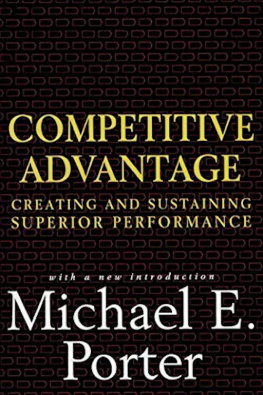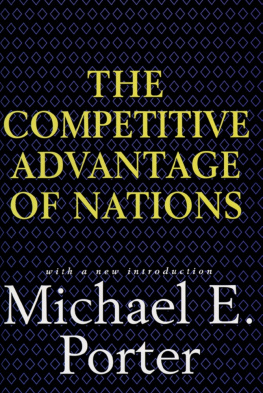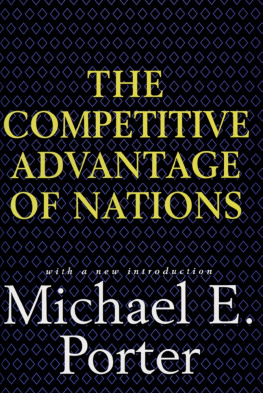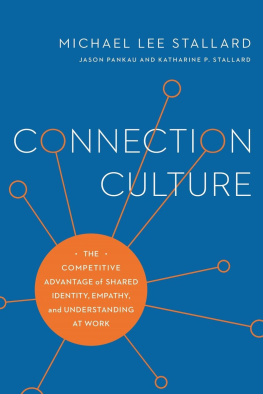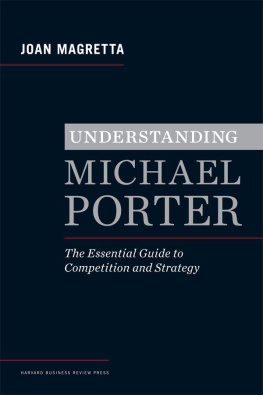Michael E. Porter - Competitive Advantage: Creating and Sustaining Superior Performance
Here you can read online Michael E. Porter - Competitive Advantage: Creating and Sustaining Superior Performance full text of the book (entire story) in english for free. Download pdf and epub, get meaning, cover and reviews about this ebook. year: 2008, publisher: Simon and Schuster, genre: Business. Description of the work, (preface) as well as reviews are available. Best literature library LitArk.com created for fans of good reading and offers a wide selection of genres:
Romance novel
Science fiction
Adventure
Detective
Science
History
Home and family
Prose
Art
Politics
Computer
Non-fiction
Religion
Business
Children
Humor
Choose a favorite category and find really read worthwhile books. Enjoy immersion in the world of imagination, feel the emotions of the characters or learn something new for yourself, make an fascinating discovery.
- Book:Competitive Advantage: Creating and Sustaining Superior Performance
- Author:
- Publisher:Simon and Schuster
- Genre:
- Year:2008
- Rating:3 / 5
- Favourites:Add to favourites
- Your mark:
- 60
- 1
- 2
- 3
- 4
- 5
Competitive Advantage: Creating and Sustaining Superior Performance: summary, description and annotation
We offer to read an annotation, description, summary or preface (depends on what the author of the book "Competitive Advantage: Creating and Sustaining Superior Performance" wrote himself). If you haven't found the necessary information about the book — write in the comments, we will try to find it.
Competitive Advantage: Creating and Sustaining Superior Performance — read online for free the complete book (whole text) full work
Below is the text of the book, divided by pages. System saving the place of the last page read, allows you to conveniently read the book "Competitive Advantage: Creating and Sustaining Superior Performance" online for free, without having to search again every time where you left off. Put a bookmark, and you can go to the page where you finished reading at any time.
Font size:
Interval:
Bookmark:
Thank you for purchasing this Free Press eBook.
Join our mailing list and get updates on new releases, deals, bonus content and other great books from Free Press and Simon & Schuster.
C LICK H ERE T O S IGN U P
or visit us online to sign up at
eBookNews.SimonandSchuster.com
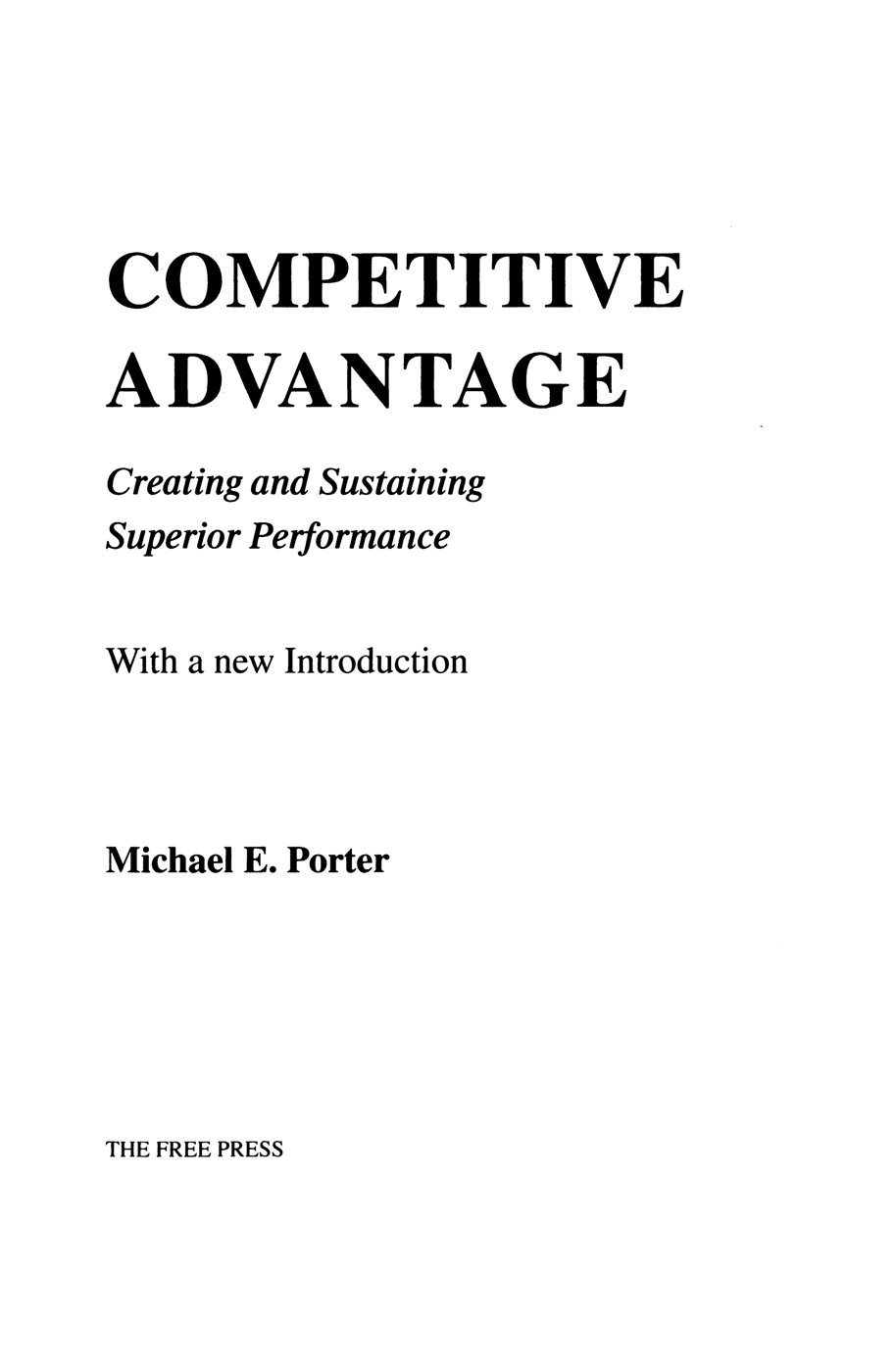
To
C. Roland Christensen
and
Richard E. Caves
Competitive Advantage was published in 1985 as the essential companion to Competitive Strategy. While Competitive Strategy concentrates on the industry, Competitive Advantage concentrates on the firm. My quest was to find a way to conceptualize the firm that would expose the underpinnings of competitive advantage and its sustainability.
At the books core is an activity-based theory of the firm. To compete in any industry, companies must perform a wide array of discrete activities such as processing orders, calling on customers, assembling products, and training employees. Activities, narrower than traditional functions such as marketing or R&D, are what generate cost and create value for buyers; they are the basic units of competitive advantage.
Competitive Advantage introduces the concept of the value chain, a general framework for thinking strategically about the activities involved in any business and assessing their relative cost and role in differentiation. The difference between value, that is, what buyers are willing to pay for a product or service, and the cost of performing the activities involved in creating it, determines profits. The value chain provides a rigorous way to understand the sources of buyer value that will command a premium price, and why one product or service substitutes for another. A strategy is an internally consistent configuration of activities that distinguishes a firm from its rivals.
The activity-based view of the firm also provides the foundation for thinking about strategy across multiple businesses. Competitive Advantage explores the role of complementary products or services in competition and competitive advantage in some industries. These questions are front and center again as a new wave of mergers with questionable competitive value is occurring.
Finally, the activity-based view of the firm offers a powerful framework for examining international strategy, or, more generally, competing across locations. In competing internationally, a firm can spread activities to different and multiple locations (I term this configuration ), while also gaining potential competitive advantages by coordinating activities across locations in a global network. I developed the international issues in a separate book because of Competitive Advantage s already formidable length and complexity.
Reflecting on Competitive Advantage 13 years after its publication, I am first and foremost heartened by the widespread acceptance of its essential concepts. The phrases competitive advantage and sustainable competitive advantage have become commonplace. The concept of activities has not only been prominent in treatments of competition and strategy but also in exploring more functional issues such as service management and the role of information technology in competition. Activity-based costing is becoming a new standard in management accounting, even though it has yet to achieve its potential as a tool for strategy.
Looking back, Competitive Advantage is also a source of particular satisfaction to me as a scholar. While Competitive Strategy drew on a rich tradition in industrial economics, Competitive Advantage had no clear antecedents in the literature on management or economics. Instead, it emerged more from my attempt to solve a puzzle. How could we find a systematic way to examine the roots of competitive advantage that tied directly to cost and differentiation and revealed the essential differences between firms without intractable complexity? I am more persuaded now than ever that activities provide the essential tool. As my work has progressed, the concept has proven even more powerful than I anticipated.
Why? Competitive Advantage offers a way to go beyond broad or unidimensional characterizations of competitive advantage. Much early work in the field ascribed advantage to overall size or market share. This was clearly too simple for several reasons. First, size and share are far more important to cost or differentiation in some parts of the business than others. Moreover, small- and medium-sized firms outperform larger firms in many industries. Finally, even where size and share are associated with superior performance, they are often outcomes of other competitive advantages, not the causes.
Other attempts to explain competitive advantagee.g., strengths and weaknesses, key success factors, or distinctive competenciesall rightly recognize that a firm is multidimensional, but offer no way to explore the sources of advantage systematically or rigorously, much less link them to profitability. Competitive Advantage starts with the premise that competitive advantage can arise from many sources, and shows how all advantage can be connected to specific activities and the way that activities relate to each other, to supplier activities, and to customer activities. The book also addresses the underlying causes of advantage in an activity: why firms achieve lower cost and how activities create tangible buyer value. It highlights the fact that the most robust competitive positions often cumulate from many activities. Advantage resting on a few activities is easier to diagnose and often easier to imitate. Finally, activities and the value chain provide a view of the firm as an interdependent system in which individual parts must be internally consistent.
More broadly, Competitive Advantage has helped make strategy more concrete and actionable. Activities, because they are what firms do, are observable, tangible, and can be managed. Strategy is no longer just a broad vision, but the particular configuration of activities a firm adopts compared to its rivals. A lowest-cost strategy involves one set of activity choices, differentiation another.
Activities provide the bridge between strategy and implementation. When strategy was defined in terms of broad positioning concepts, a clear separation between strategy and structure was meaningful and useful. What and how were comparatively distinct. Armed with the recognition that a firm is a collection of discrete activities, however, previously common distinctions between strategy, tactics, and organization blur. Strategy becomes the particular array of activities aligned to deliver a particular mix of value to a chosen array of customers. The configuration of each activity embodies the way that activity is performed, including the types of human and physical assets employed and the associated organizational arrangements. Competencies, then, become part of specific activities rather than abstract and disconnected from cost and buyer value.
Functions that are normally thought of as organizational, such as compensation systems, training, and even overall decisionmaking architecture, are also activitiesI call them support activities to distinguish them from activities directly involved in producing, delivering, marketing, or servicing a firms product. Support activities can be sources of competitive advantage in their own right. The configuration of activities for competing in a particular way also shapes the appropriate contractual relations with employees and other firms. Activities also provide a framework for drawing appropriate organizational boundaries.
Activities, then, make strategy operational. Said differently, seeing the firm as a collection of activities makes it clear that everyone in a firm is part of strategy. It also makes clear why many employees must understand the strategy, so that the rationale behind the configuration of their activity and how it relates to others is evident.
Next pageFont size:
Interval:
Bookmark:
Similar books «Competitive Advantage: Creating and Sustaining Superior Performance»
Look at similar books to Competitive Advantage: Creating and Sustaining Superior Performance. We have selected literature similar in name and meaning in the hope of providing readers with more options to find new, interesting, not yet read works.
Discussion, reviews of the book Competitive Advantage: Creating and Sustaining Superior Performance and just readers' own opinions. Leave your comments, write what you think about the work, its meaning or the main characters. Specify what exactly you liked and what you didn't like, and why you think so.

